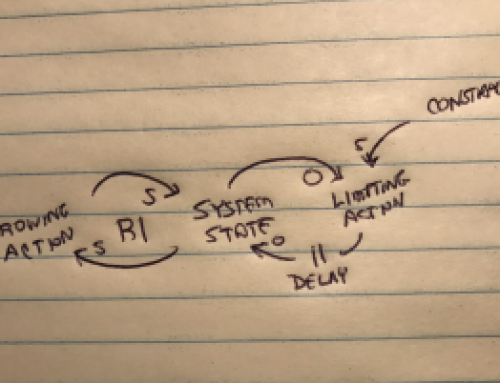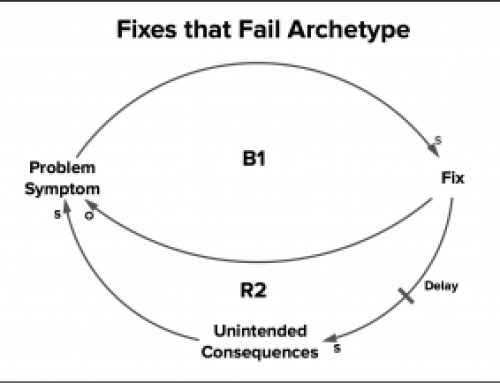In my recent series focused on the leadership required to build a learning organization, I examined key leadership activities, attitudes, and behaviors that will fuel, drive, and inspire a learning environment. These leadership behaviors and activities are one of the three key “change forces” that I discussed in the blog post that set the foundation for this series (“Change Forces & The Learning Organization”). I am now going to shift our focus to the second of those change forces – Accepted Information and Routines.
In review, the figure to the right appeared in that foundation post on this topic and lists all three of these change forces — Leadership Behavior & Actions, Accepted Information & Routines, and finally Individual & Group Actions. These three forces drive change in an organization and are the foundational pieces of the learning organization. The learning organization is about eliminating “episodic” change and the requirement that management turn change into an event. A learning organization is constantly moving through stages of information gathering, reflection, contending and contesting information and routines, examining opportunities and problems alike within a total systems thinking model, innovating forward by creating new solutions and opportunities, and then acting on what is learned. These three power centers .. change forces .. drive the learning organization engine.
How do you acquire and/or create information?
How you use, interpret, and act on available information is of course at the heart of the “accepted information & routines” change force that I want to focus on in this series of blog articles, so that begs the questions of “what information are you examining?” ad “what is the source of this information?”
Data (Information) can be gathered or created across three basic methods — searching existing information, creating new information through inquiry, and acquiring new information by manes of observation. Given the space available in a blog post, I am only going to touch on each one briefly and then give each some additional focus in future posts along with probing more deeply at some of the adequacies and inadequacies that must be considered to ensure that you get the “right” data.
Search
Searching existing information is something that most leaders and organization leadership as a whole does as a natural function of their jobs. By this I mean that this is part of a daily routine. Sales leaders examine data coming to them from their CRM tool. Brand managers or product managers monitor competing brands and product releases, Sales personnel watch for press releases on new products, changes in sales contacts, new companies in the market they serve. And of course, everyone hears rumors, news, or other tidbits of information from their network of contacts or others in the organization. Your company may also subscribe to services relating to competitive market share, analyst reports, wire services, new lead generating services, etc.
Creating through Inquiry
Creating new information through inquiry is, in essence, research. When searching existing information, discussed above, you recognize of course that not ALL information already exist, therefore, search falls short in creating new information that is likely necessary. There is tremendous power in asking questions. Hopefully, asking questions is a key part of how you manage and work. How often do your customers buy? How long do customers user a product before replacing? What are the key features that customers are currently looking for? What are the key weaknesses of our product in light of customer expectations? Which competitor has a better product and why? The options for questions are seemingly endless and of course part of being a learning organization is giving opportunity for those in the organization to develop questions, challenge assumptions, probe beyond the obvious, interact with customers and gain insight, interact with each other to develop new questions that weren’t obvious, etc. This function of inquiry only improves as you build a learning organization.
Acquiring by means of Observation
The last method is acquiring information by means of observation which is certainly closely related to inquiry but instead of asking questions this takes the forms of observing individuals, groups, or processes performed by these and at times also participation along with observation. If search has the limitation of finding only existing information, and inquiry relies on asking the right question, then this final methodology serves to uncover ideas, questions, information, that is more of a “ah-ah” or surprise. In fact, many times these “ah-ah” moments can only occur while observing. One auto manufacturer sent a team to the parking lot of theme park just to observe carloads of people arriving and departing so they could watch how people use their cars, their doors, their trunks, etc. There is of course, the well known “Undercover Boss” television show that demonstrates the power of observation at work very clearly.
The point is that observation may uncover unexpected results such as processes that are “out of the box” that should be implemented formally, feelings or needs within the organization that were previously unknown, failing processes or complicated processes that simply don’t serve the company, workarounds that should be unnecessary, and even a few into the accepted “routines” or “norms” that people may fall into that cut short opportunities for additional learning.
Summary
After reading this, you may already be wondering how much you and your organization invest in each of these areas, whether in terms of time or actual money. You should be asking that question. There is no doubt that search is a part of the daily routine of many of your leaders, but perhaps you may wonder if they only do what comes easy in that regard and fail to put work into search. Inquiry is something every company might say they do, but the truth is that without diligence and attention, actual research such as “voice of the customer” work or even basic feedback may be intermittent or superficial at best. Even more troublesome might be the actual implementation of any formal observation plan or methodology, or the effectiveness of what is done without more formal training. For example, there are many, many sales leaders that fully believe they are observing sales team members by traveling with them on sales calls, and yet, the actual activity that may be occurring is the sale team member is observing the sales leader making the call, doing the talking, in essence, taking over. So who is observing who then?
With this introduction in place, I will now give additional focus to each area and push you to understand the true commitment, perseverance, and skills required to take advantage of each of these areas as appropriate to ensure that you get the RIGHT data before you even begin interpreting data, reacting to data, or creating new action plans based on that data.


